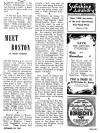
|
MEET BOSTON Friday, December 26, 1941 in What's New In Town W. J. Sidis |
North Station is the only metropolitan building housing a hotel, a depot and a sports arena under one roof.
*
In Puritan days, there was only one institution of higher learning in America. This was Harvard College, chartered in 1636, and opened in 1639. It was originally operated jointly by the Province and the Congregational Church, the charter being copied verbatim into the Commonwealth constitution, which ratified and confirmed it. All sectarian connection, however, was broken about the time of the Civil War, when it was given a new form of government in which all alumni of 25 years’ standing were given a vote. This institution is not entirely in Cambridge; the Stadium, the Business School and the Medical and Dental Schools are within Boston’s city limits. During the siege of Boston (1775) the college moved to Concord, while the rebel forces occupied the college buildings. Massachusetts Hall in the college yard, built in 1720, is the oldest college building in the country.
*
Several streets in Boston, including Savin Hill Avenue in Dorchester, and Nottinhill Road in Brighton, literally meet themselves coming back. These streets loop around a hill, and end up farther back along the street, thus producing a corner from which the same street radiates in three different directions.
*
Puritanism, as known to New England, implied no definite fixed dogmas. Each Massachusetts town determined for itself, by vote of the citizens in town meeting, just what the doctrines and policies of its churches should be. For instance, the official Puritan doctrines in Brookline were so much more liberal than those prevailing in neighboring towns that the “orthodox” Puritans there had to attend church in Roxbury. On account of the independence of the various congregations, the Puritan church later dropped the name of Congregational. The name Puritan had no implication of so-called “purity” of life, as they made no claim to being ascetics. They got their name from the fact that they sought to “purify” the Church of England of alleged pagan influence.
*
How much of Boston has been filled in can be seen from the presence of such names as Dock Square, Salt Lane, and Beach Street, at points now far removed from the water. On the Cambridge side of the river, such names as River Street, Dock Street, and Front Street at points now inland, point to the same thing.
*
In traveling from the Watertown Car House to downtown Boston by the nearly straight route of taking the trolley to Central Square in Cambridge, then by subway downtown, the Charles River is crossed no less than four times in about six miles. The somewhat more roundabout route of the direct car via Newton and Brighton avoids crossing the river.